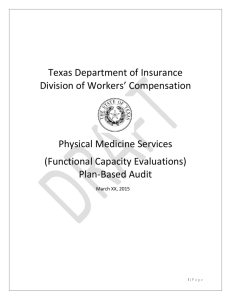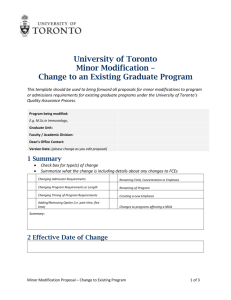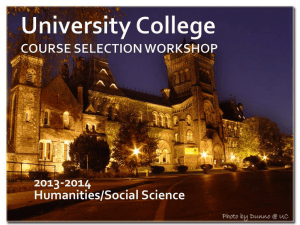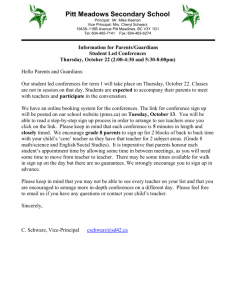Guest Editors' Introduction - Lundquist College of Business
advertisement
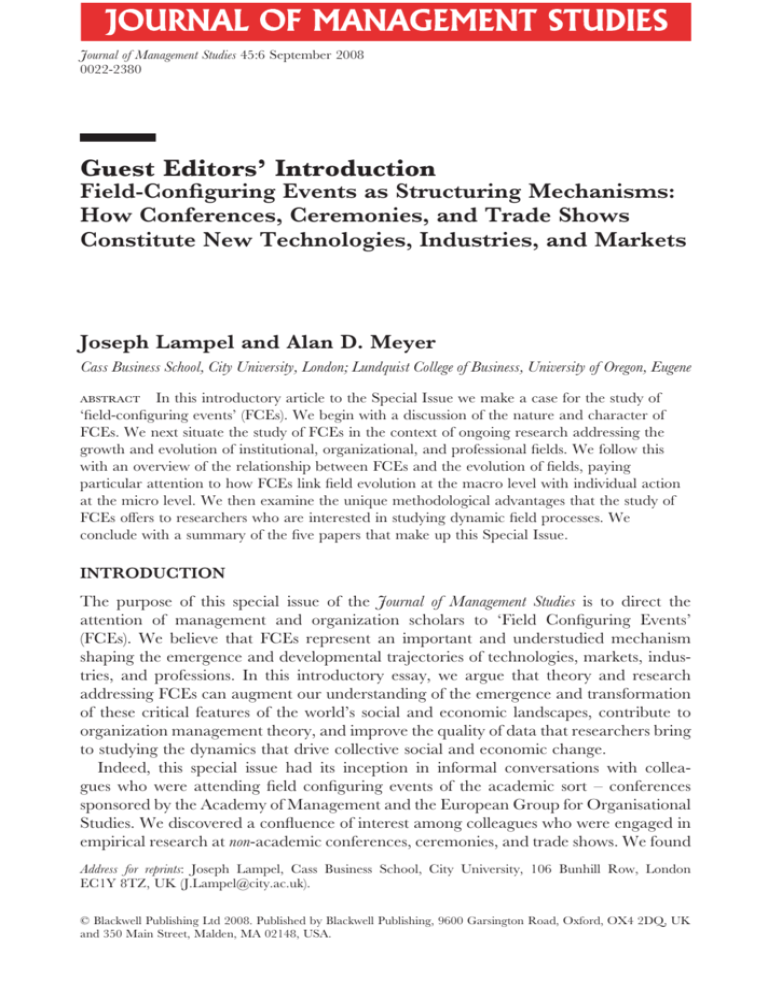
Journal of Management Studies 45:6 September 2008 0022-2380 Guest Editors’ Introduction Field-Configuring Events as Structuring Mechanisms: How Conferences, Ceremonies, and Trade Shows Constitute New Technologies, Industries, and Markets Joseph Lampel and Alan D. Meyer Cass Business School, City University, London; Lundquist College of Business, University of Oregon, Eugene abstract In this introductory article to the Special Issue we make a case for the study of ‘field-configuring events’ (FCEs). We begin with a discussion of the nature and character of FCEs. We next situate the study of FCEs in the context of ongoing research addressing the growth and evolution of institutional, organizational, and professional fields. We follow this with an overview of the relationship between FCEs and the evolution of fields, paying particular attention to how FCEs link field evolution at the macro level with individual action at the micro level. We then examine the unique methodological advantages that the study of FCEs offers to researchers who are interested in studying dynamic field processes. We conclude with a summary of the five papers that make up this Special Issue. INTRODUCTION The purpose of this special issue of the Journal of Management Studies is to direct the attention of management and organization scholars to ‘Field Configuring Events’ (FCEs). We believe that FCEs represent an important and understudied mechanism shaping the emergence and developmental trajectories of technologies, markets, industries, and professions. In this introductory essay, we argue that theory and research addressing FCEs can augment our understanding of the emergence and transformation of these critical features of the world’s social and economic landscapes, contribute to organization management theory, and improve the quality of data that researchers bring to studying the dynamics that drive collective social and economic change. Indeed, this special issue had its inception in informal conversations with colleagues who were attending field configuring events of the academic sort – conferences sponsored by the Academy of Management and the European Group for Organisational Studies. We discovered a confluence of interest among colleagues who were engaged in empirical research at non-academic conferences, ceremonies, and trade shows. We found Address for reprints: Joseph Lampel, Cass Business School, City University, 106 Bunhill Row, London EC1Y 8TZ, UK (J.Lampel@city.ac.uk). © Blackwell Publishing Ltd 2008. Published by Blackwell Publishing, 9600 Garsington Road, Oxford, OX4 2DQ, UK and 350 Main Street, Malden, MA 02148, USA. 1026 J. Lampel and A. D. Meyer that our work in gathering and analysing field data in these venues was evoking similar reactions: (1) All of us found these events to be unexpectedly fertile settings for collecting rich data. (2) We concluded that they often gave rise to critical turning points in the emergence and development of the social, economic, and technological structures we were studying. (3) Entering these settings as participant observers gave us unmatched opportunities to interact with practitioners in their own language and on their own turf – they opened a unique window on participants’ social, occupational, and organizational worlds. We recruited other like-minded colleagues, and adopted the phrase ‘field configuring events’ to label the social collectives we were studying. We refined the FCE concept by organizing a symposium in 2003 and a professional development workshop in 2004 at Academy of Management conferences. Interest in FCEs grew and coalesced in 2005 as an invitation from the editors of JMS to solicit papers for possible publication as a special issue focusing on FCEs. A call for papers went out, many scholars sent us their work, and others were recruited to review these papers. The five articles published in this issue were finally winnowed and developed through two rounds of double-blind reviewing. We preface these papers by defining Field Configuring Events and going on to explain why we believe they merit scholarly attention. We argue that paying heed to FCEs can yield new theory, generate high-quality field data, and advance our understanding of organizing and managing. DEFINING FIELD CONFIGURING EVENTS Field-Configuring Events (FCEs) are temporary social organizations such as tradeshows, professional gatherings, technology contests, and business ceremonies that encapsulate and shape the development of professions, technologies, markets, and industries (Meyer et al., 2005). They are settings in which people from diverse organizations and with diverse purposes assemble periodically, or on a one-time basis, to announce new products, develop industry standards, construct social networks, recognize accomplishments, share and interpret information, and transact business. FCEs are arenas in which networks are constructed, business cards are exchanged, reputations are advanced, deals are struck, news is shared, accomplishments are recognized, standards are set, and dominant designs are selected. FCEs can enhance, reorient, or even undermine existing technologies, industries, or markets; or alternately, they can become crucibles from which new technologies, industries, and markets emerge. Recognizing this, their organizers often design FCEs with an eye towards influencing field evolution. Organizers’ intentions are not always realized, of course. FCEs often fail to achieve intended outcomes, or these are eclipsed by unplanned and unanticipated outcomes. Thus, FCEs that were designed to shape field evolution may (or may not) have the intended effects, depending on contingencies lying beyond the control of the organizers. On the other hand, FCEs that were never intended to influence field evolution may trigger emergent processes that redirect the field’s developmental trajectory. FCEs have six defining characteristics, which for purpose of this Special Issue constitute an operational definition: © Blackwell Publishing Ltd 2008 Guest Editors’ Introduction 1027 1. FCEs assemble in one location actors from diverse professional, organizational, and geographical backgrounds. 2. FCEs’ duration is limited, normally running from a few hours to a few days. 3. FCEs provide unstructured opportunities for face-to-face social interaction. 4. FCEs include ceremonial and dramaturgical activities. 5. FCEs are occasions for information exchange and collective sense-making. 6. FCEs generate social and reputational resources that can be deployed elsewhere and for other purposes. THEORETICAL ORIGINS AND CONTRIBUTIONS The study of field configuring events must be situated in the context of ongoing research addressing the growth and evolution of institutional, organizational, and professional fields (Davis and Marquis, 2005). Early institutional theorists devoted little attention to the origins of fields, and explicitly excluded human agency as a factor in their formation. More recently, scholars have turned their attention to the emergence of institutions and fields (Farjoun, 2002; Meyer et al., 2005). Thus far the new research suggests that fields begin as agglomerations of individuals, groups, and organizations that meet sporadically at first, and then come into contact with increasing frequency. These contacts foster competitive and collaborative interactions, and depending on the specific local circumstances and individual strategies they can trigger field evolution (Powell et al., 2005). At some point early in the evolution of a field, the density and intensity of participants’ interactions reach critical thresholds at structural and cognitive levels (Meyer et al., 2005). At the structural level, the field begins to acquire macro structural features that reinforce field permanence (Barley and Tolbert, 1997; Giddens, 1979). By contrast, at the cognitive level field members gain awareness of the field in its totality, and acquire identity as field members (Rao, 1994). The two levels, the structural and cognitive, reinforce each other. Field members build cognitive representations of the agglomeration as an interactive and evolving entity alongside representations of their own positions in this entity (Garud and Karnøe, 2004). They invest energy and resources in the field with a view to future returns, and by doing so they increase the field’s institutional legitimacy. Extant literature on field formation and development has tended to focus on the general evolutionary outlines of the process (Lounsbury et al., 2003). This is understandable inasmuch as researchers were trying to grasp the totality of the phenomenon of field formation and development before beginning the painstaking task of probing the complex micro structures that link the activities of individual actors with the evolution of the field as a whole. But current theory of field formation and development seems to focus almost exclusively on global and continuous processes that drive field evolution, while paying little attention to discontinuous and localized processes such as field configuring events that play an important, albeit intermittent, role in shaping the evolution of fields. The study of field configuring events should therefore be seen as part of a reorientation of research on field evolution towards mechanisms of institutional change that lack temporal continuity. A major impetus for this reorientation is a new-found interest in the linkages between the actions of field members and the emergence and development of © Blackwell Publishing Ltd 2008 1028 J. Lampel and A. D. Meyer fields (Fligstein, 2001; Meyer et al., 2005; Rao, 1994). In substantive terms, this exploration has focused on field configuring events as mechanisms that play a role in shaping technological artefacts, market boundaries, and regulatory frameworks. SUBSTANTIVE IMPACT OF FCEs ON THE EVOLUTION OF FIELDS Field configuring events are both the products and the drivers of field evolution. At certain junctures in their development fields generate field-configuring events as structuring mechanisms, and at others, field-configuring events trigger processes that drive field evolution. FCEs and field evolution therefore have a recursive relationship with each other: the evolution of fields foments FCEs, and FCEs insert themselves into the evolution of fields. This means that under certain conditions the field gives rise to FCEs, but once they come into being, FCEs generate their own evolutionary pressures that further shape the field’s cognitive, normative, and/or social structures. The precise manner in which fields foster the formation of FCEs will depend on a variety of factors: the presence of institutional entrepreneurs, tendencies to mimic more established fields, and the intervention by external actors (e.g. governments). By the same token, the influence of FCEs on field evolution will likewise depend on the nature of both the FCE and the field itself. Some FCEs have a strong ‘field mandate’ in the sense that they can exercise powerful influence on the future evolution of the field. This happens when key actors accord the FCE formal authority in specific domains, or when the FCE achieves a quasi-monopolistic legitimacy position (e.g. professional conferences such as annual meetings of the American Bar Association, or the US government’s DARPA Grand Challenge, an annual contest designed to encourage the development of selfdriving vehicles). In other cases, FCEs have a weak field mandate, and influence field evolution indirectly, serving primarily as social networking hubs. This means that the evolution of the field is steered by emergent processes: field members meet, converse, negotiate, explore joint actions, and develop projects. They do not exercise influence as a collective body, but as a set of overlapping circles, cliques, and groups. Field-configuring events therefore create a social space in which individuals can represent both themselves and their organizations. This duality is crucial for understanding the unique role that FCEs play in the evolution of fields. Most field theories see the evolution of fields as taking place primarily through interactions between the organizations that make up the field. But the evolution of fields also occurs through the interaction of individuals, whether acting as agents of organizations, or on their own behalf. From a theoretical point of view this presents researchers with what has been termed the ‘paradox of embedded agency’ (Holm, 1995): if individuals conform to the institutional logic of their field they will behave exactly as their organizations or professions prescribe. But if they do so, they are no longer actors in any meaningful sense of the term. One way around this paradox is for researchers to focus on field structures that give organizations influence over processes, while at the same time allowing individuals latitude to act in light of their own understanding of the situation. A virtue of field configuring events is that they allow individuals greater scope for interaction, yet at the same time they are structured in conformity with the institutional logic of the field. In effect, field-configuring events protect individual initiative and creativity from the © Blackwell Publishing Ltd 2008 Guest Editors’ Introduction 1029 relentless isomorphic pressures of institutional field logics, but then select from the outputs of these events those novel products, ideas, or actions that come to be valued within the field. The evolutionary dynamics of technology illustrates this duality. The evolution of technology has traditionally been approached from two contrasting perspectives. On the one hand, the development of new technologies has been seen as the inevitable consequence of institutions such as markets which set demand for new products, scientific communities that generate new insights, and patent systems that safeguard intellectual property. The actions of individuals (or for that matter organizations) in relationship to these institutions are seen as fully explained by institutional imperatives; with individuals functioning for the most part as subservient agents rather than autonomous actors. A contrasting perspective on the evolution of technologies singles out individuals as the authors of technological change. Individuals not only invent new devices, but through their social interactions they build collective knowledge that guides the development of technologies. Technologies are therefore negotiated artefacts whose designs and dynamics are determined by collective cognitions. Field configuring events offer middle-range mechanisms that bridge the gap between these two perspectives. Bijker et al. (1987), for example, describe how technology contests such as bicycle races provide individual inventors with an arena for demonstrating, displaying, and promoting their designs. Within this arena, rules that define performance are institutional and external. Viewed as a field configuring event, the race becomes a contest that creates reputational resources that can be used elsewhere, even though they are based on the single criterion of speed. In a similar vein, Garud and Rappa (1994) show how standards-setting conferences act as field configuring events that mediate the interaction between institutions and actors. At the macro level, institutions such as the FDA and NIH define generic standard-setting guidelines that are subject to conflicting interpretations. At the micro level, representatives of individual organizations are bent on interpreting guidelines to suit their own technological agendas. Field configuring events switch on mechanisms mediating between the two levels. They construct arenas that replicate macro institutional mandates for specific purposes, while at the same time giving individuals the opportunity to transform contested arguments into legitimated outcomes (McInerney, 2008 (this issue)). Thus, research on the role of field configuring events has thrown light on the emergence and dynamics of markets and industries. In the emergence phase, FCEs’ focus is on the processes that transform a disparate set of organizations and individuals into a ‘community of organizations that partake of a common meaning system’ (Scott et al., 2000). In this phase, the role of an FCE is more likely to involve normative issues such as setting standards, defining practices, and codifying key vocabularies, as well as positioning the field relative to other fields and institutions. As fields move from emergence towards maturity, the role of FCEs tends to change to one of field replication. Here, FCEs are more likely to focus on expanding, refining, and solidifying beliefs and practices, as well as tracking and reinforcing field position relative to other fields and institutions. More attention is therefore paid to creation of field-specific social capital, to activities that protect and reinforce field identity and boundaries, and to ceremonies that legitimate dominant norms and logics. Several studies illustrate FCEs in both phases. © Blackwell Publishing Ltd 2008 1030 J. Lampel and A. D. Meyer Aldrich and Fiol (1994) highlighted the role that industry associations play in industry emergence. In their study of the first nanotechnology investment conference, Meyer et al. (2005) showed how a field configuring event transformed a scientific technology into a recognized commercial sector. Anand and Watson (2004), by contrast, examined the impact of award ceremonies on industry evolution, showing how the Grammy awards generated new musical genres that reoriented the commercial music industry. Finally, recent work on institutional entrepreneurship sheds light on field configuring events. Greenwood and Suddaby (2006, p. 29) define institutional entrepreneurs as ‘organized actors who envision new institutions as a means of advancing interests they value highly yet that are suppressed by extant logics’. Field configuring events are often championed and organized by institutional entrepreneurs with an overt field-building agenda, but also with a view towards private gains. For example, the 1851 World Trade Fair in London was championed as a showcase for British industry by Prince Albert, the consort of Queen Victoria. But it was also part of Prince Albert’s personal campaign to gain acceptance among the British public. Lampel (2001) has shown how market entrepreneurs often turn into institutional entrepreneurs, orchestrating elaborate technology demonstrations as a way of assembling resources and gaining consumer acceptance. METHODOLOGICAL ADVANTAGES OF STUDYING FCEs Field configuring events present unique methodological opportunities to social scientists. First, they facilitate the study of emergence, transformation, and other dynamic processes that are difficult to capture with conventional methodologies (Chiles et al., 2004). Existing social scientific methods tend to produce static descriptions of historical events and structures at rest. These tools leave social scientists ill-equipped to investigate how intentions shape actions, how individuals’ beliefs coalesce into collective cognitions, and how cognitions solidify into social structures capable of reproducing themselves and enacting their environments. FCEs are social microcosms that can foreshadow and simulate an unrealized shared vision of a focal technology, market, or industry. In tractable settings bounded by time and space, they allow researchers to directly observe the sense-making and sensegiving processes that fuel field formation and transformation. This can be done through realtime collection of primary data (Garud, 2008 (this issue)), historical analysis of archival data (Oliver and Montgomery, 2008 (this issue)), or by combining both forms of data (Glynn, 2008 (this issue); McInerney, 2008 (this issue); Meyer et al., 2005). A second fundamental methodological advantage offered by FCEs is the routine generation of large quantities of accessible, rich, and varied data. Most FCEs are announced and publicized in advance. As a rule, they leave an explicit and documented record of their proceedings. FCEs typically assemble key insiders in a public location – unlike more private gatherings they allow outsiders’ access to field-focused deliberations and decisions. FCEs therefore allow researchers to make the most of scarce resources when employing potentially costly data collection methods such as administering surveys or conducting interviews (Lampel and Shapira, 1995). The methodological orientation of research on FCEs reflects the dual nature of these events as both organizations with structure and strategic goals, and social micro© Blackwell Publishing Ltd 2008 Guest Editors’ Introduction 1031 cosms that depend on the subjective interpretation of participants. Researchers that focus primarily on the structural and strategic aspects of FCEs generally adopt survey and case study methodologies that is consistent with event planning. For example, Blythe (2000) collected survey data on the reasons that firms attend trade shows. Seringhaus and Rosson (2001) likewise used a survey to study whether firms that attended trade shows more frequently benefited from their experience when planning their participation. By contrast, Gopalakrishna et al. (1995) collected data on one firm’s interaction with potential customers during trade shows to determine whether this yielded additional sales. Barbato and Mio (2007) used archival records of the Venice Biennale to reconstruct the organizational evolution of one of the most influential field configuring events in European cultural life. Lampel (2001) conducted a series of case studies to examine the impact of technological dramas on the evolution of technological fields. Evans (2007) used case studies of three major European film festivals to examine the differentiation of European cinema from its Hollywood counterpart. In this Special Issue, Anand and Jones use archival data to reconstruct the evolution of the Booker Prize, and Glynn utilizes raters to assess the residual legacy of Olympics Games. By contrast, researchers that focus on how the social dynamics of FCEs impact field evolution rely heavily on participant observation, interviews, and texts produced by participants. Much of this research focuses on conferences. Conferences are ideal settings for researchers trying to recruit informants to provide primary qualitative data. Conferences assemble prospective informants in a public space, and label them with identifying nametags. People attending conferences typically adopt roles that facilitate informal interviews: they come expecting to be approached by strangers, are predisposed to respond politely, and offer a business card listing their name, job title, employing organization, and contact information. The papers by Oliver and Montgomery (2008 (this issue)), Garud (2008 (this issue)), and McInerney (2008 (this issue)), use a variety of methodologies to study conferences as field-configuring events. Oliver and Montgomery perform content and network analysis on verbatim transcripts of a one-day congress of Jewish lawyers to study the evolution of the legal field in pre-independence Israel. Garud adopts ethnographic methods to study the impact of professional association conferences on standard setting in technological fields. McInerney uses a combination of ethnographic and historical methods to reconstruct a sociological history of the non-profit technology assistance providers movement from its inception to the point at which it becomes an institutional field. While Oliver and Montgomery focus on a one-time FCE, in their respective studies Garud and McInerney examine a sequence of FCEs, thus pointing to another methodological advantage of FCE research. When FCEs are scheduled to occur periodically, studying them allows a researcher to track field evolution, in effect, moving from a series of cross-sectional snapshots of field structure towards a motion picture, albeit a jerky one, portraying field evolution. More generally, conferences, festivals, and award ceremonies that are convened to construct organizational fields and technologies present researchers with a wide array of data (Meyer et al., 2005). These can include: (1) printed programmes that identify preeminent experts and personalities in the field, and articulate crucial issues and © Blackwell Publishing Ltd 2008 1032 J. Lampel and A. D. Meyer challenges; (2) rosters listing attendees’ names, organizational affiliations, occupations, achievements, and contact information; (3) conference sponsors – organizations that have agreed to subsidize the FCE in order to signal their association with the field and assimilate it into their organizational identities; (4) performances, presentations, and panel discussions that document current sense-making gambits, highlight field-specific jargon, and diffuse best practices; and (5) naturalistic observation of informal and backstage social processes that include identity work, network formation, product promotion, and deal making. OVERVIEW OF PAPERS The opening paper, ‘Tournament Rituals, Category Dynamics, and Field Configuration: The Case of the Booker Prize’ (Anand and Jones, 2008) examines the structuring role that award ceremonies play in the evolution of fields. N. Anand and Brittany Jones analyse the history of this British literary prize since its inception in 1968. They interpret the Booker as a value conferring tournament expressed as a public ritual that has reconfigured contemporary English-language literature by creating a distinctive new category, British Postcolonial Fiction. Anand and Jones show how the Booker’s organizers fomented controversy in order legitimate the award’s claim to innovation. The next paper, ‘Conferences as Venues for the Configuration of Emerging Organizational Fields: The Case of Cochlear Implants’ (Garud, 2008) examines how conferences shape technological fields. Raghu Garud studied conferences that were not solely designed for information-exchange, but also as arenas for competition among self-interested contestants advocating different devices. Taking a ‘sociology of associations’ perspective, Garud describes intensive fieldwork he conducted by attending conferences sponsored by two professional associations – the 1985 meeting of the American Academy of Otolaryngology and the 1987 meeting of the American Speech Language and Hearing Association. At both conferences, a bitter dispute erupted between proponents of one cochlear implant device that employed a single electrode and another employing multiple electrodes. Garud observed the dispute’s resolution while attending a third standard-setting conference hosted by the National Institute of Health (euphemistically dubbed a ‘consensus’ conference). Garud’s analysis documents the micropolitics through which FCE-focused contestation can deflect a technology’s developmental trajectory. In the next paper, ‘Showdown at Kykuit: Field-Configuring Events as Loci for Conventionalizing Accounts’, Paul-Brian McInerney (McInerney, 2008) focuses on the role played by field configuring events in the transformation of a loose network of individuals and grassroots organizations engaged in providing technology consulting services to non-profit organizations into a cohesive field with an established institutional identity. McInerney traces the origins of the field to the so-called ‘Circuit Rider’ movement, which took its name from itinerant travelling preachers who roamed frontier America in the 18th century. Supported by grants, the individuals and organizations in this social movement filled an important information technology gap in the operations of non-profit organizations. As the movement took shape, it began to articulate an ethos and an identity through what McInerney terms ‘conventionalizing accounts’. But it took the © Blackwell Publishing Ltd 2008 Guest Editors’ Introduction 1033 intervention of Rob Stuart, a fellow at the Rockefeller Family Fund, to begin the process of transforming this loose network into a cohesive field. Beginning in 1998, Stuart convened planning meetings targeted at recruiting support from large foundations that provided grants to non-profits. These meetings culminated in a three-day conference in Kykuit, New York, where Stuart’s intended launch of a ‘National Strategy for Non-profit Technology’ was derailed. The foundation officers in attendance stripped the mantle of legitimacy from Stuart, and conferred it instead upon Npower – a subsidiary of Microsoft. McInerney’s analysis shows how competition between rival ‘conventionalizing accounts’ can shape field evolution. Mary Ann Glynn’s paper, ‘Configuring the Field of Play: How Hosting the Olympic Games Impacts Civic Community’ (Glynn, 2008) shifts the focus to FCEs’ impact upon geographically based fields. Glynn examines how hosting the Olympics affects metropolitan fields by catalysing the restructuring of civic, social, and business networks. In a two-part analysis, she first explores the intended and actualized legacies imprinted by the Olympics upon host cities between 1972 and 2006. Next, she focuses her attention on the Atlanta Olympics as a case study in the transformation of a metropolitan field. She singles out Olympic sponsors’ unique role in instantiating a reconfiguring of the relational links and symbolic system comprising Atlanta’s metropolitan field. Glynn’s analysis shows how key actors used the process of field reconfiguration to stake new positions that they could exploit in post-Olympics Atlanta. In the final paper, ‘Using Field-Configuring Events for Sense-Making: A Cognitive Network Approach’, Amalya Oliver and Kathleen Montgomery (Oliver and Montgomery, 2008) examine the sense-making role that field-configuring events can play in forging shared cognitions. They study a pivotal ‘Congress of Jewish Lawyers’ held in 1944 in the yet-to-emerge state of Israel. Participants arrived with disparate preferences and preconceptions regarding a viable legal and judicial institutional framework for Israel. Working from verbatim transcripts of the one-day congress, Oliver and Montgomery extract data via content analysis, and then map the shared cognitive field by subjecting it to network analysis. Their analysis suggests that this particular FCE was a turning point that helped shape the Israeli justice system. FINAL THOUGHTS The infusion of field theory into organizational scholarship is one of those felicitous conceptual migrations that, while generating a wealth of insights, presents challenges to the researchers who try to apply the new perspective to their particular areas of study. Fully accepting the claim that social fields have substantive effects, or even adopting the concept as a working hypothesis, entails a corresponding belief that fields change and evolve. But as Levi Martin (2003) points out, theories gain credibility not by simply describing change, but by specifying mechanisms that explain how change processes occur. This Special Issue is dedicated to the idea that events such as conferences, ceremonies, and trade shows are precisely the kind of mechanisms that merit close study because they play a pivotal role in field change and evolution. The case for more intensive research on FCEs is strong. Substantively, FCEs merit study because they can be turning points in the social, economic, and political transfor© Blackwell Publishing Ltd 2008 1034 J. Lampel and A. D. Meyer mation of our world. Theoretically, research on FCEs can further our understanding of the old conundrum of agency and structure, closing the theoretical gap that separates the methodological individuals that economists espouse and the methodological collectives that sociologists prefer to consider. Lastly, we see FCEs as rich, but largely ignored settings for collecting data, offering a window into practitioners’ actions when they leave their organizational routines behind, and assemble to invent a collective future. REFERENCES Aldrich, H. E. and Fiol, C. M. (1994). ‘Fools rush in? The institutional context of industry creation’. Academy of Management Review, 19, 645–70. Anand, N. and Jones, B. C. (2008). ‘Tournament rituals, category dynamics and field configuration: the case of the Booker Prize’. Journal of Management Studies, 45, 1036–60. Anand, N. and Watson, M. R. (2004). ‘Tournament rituals in the evolution of fields: the case of the Grammy awards’. Academy of Management Journal, 47, 59–80. Barbato, M. B. and Mio, C. (2007). ‘Accounting and the development of management control in the cultural sphere: the case of the Venice Biennale’. Accounting, Business and Financial History, 17, 187–208. Barley, S. R. and Tolbert, P. S. (1997). ‘Institutionalization and structuration: studying the links between action and institution’. Organization Studies, 18, 93–117. Bijker, W. E., Hughes, T. P. and Pinch, T. (1987). The Social Construction of Technological Systems. Cambridge, MA: MIT Press. Blythe, J. (2000). ‘Objectives and measures at UK trade exhibitions’. Journal of Marketing Management, 16, 203–22. Chiles, T., Meyer, A. and Hench, T. (2004). ‘Organizational emergence: the origin and transformation of Branson, Missouri’s musical theaters’. Organization Science, 15, 499–519. Davis, G. F. and Marquis, C. (2005). ‘Prospects for organization theory in the early twenty-first century: institutional fields and mechanisms’. Organization Science, 16, 332–43. Evans, O. (2007). ‘Border exchanges: the role of the European film festival’. Journal of Contemporary European Studies, 15, 23–33. Farjoun, M. (2002). ‘The dialectics of institutional development in emerging and turbulent fields: the history of pricing conventions in the on-line database industry’. Academy of Management Journal, 45, 848–74. Fligstein, N. (2001). ‘Social skill and the theory of fields’. Sociology Theory, 19, 105–25. Garud, R. (2008). ‘Conferences as venues for the configuration of emerging organizational fields: the case of cochlear implants’. Journal of Management Studies, 45, 1061–88. Garud, R. and Karnøe, P. (2004). ‘Distributed agency and interactive emergence’. In Floyd, S., Roos, J., Jacobs C. and Kellermanns, F. (Eds), Innovating Strategy Process. Oxford: Blackwell, 88–96. Garud, R. and Rappa, M. (1994). ‘A socio-cognitive model of technology evolution’. Organization Science, 5, 344–62. Giddens, A. (1979). Central Problems in Social Theory: Action, Structure, and Contradiction in Social Analysis. Berkeley, CA: University of California Press. Glynn, M. A. (2008). ‘Configuring the field of play: how hosting the Olympic Games impacts civic community’. Journal of Management Studies, 45, 1117–46. Gopalakrishna, S., Lilien, G. L., Williams, J. D. and Sequeria, I. K. (1995). ‘Do trade shows pay off?’. Journal of Marketing, 59, 75–83. Greenwood, R. and Suddaby, R. (2006). ‘Institutional entrepreneurship in mature fields: the Big Five accounting firms’. Academy of Management Journal, 49, 27–48. Holm, P. (1995). ‘The dynamics of institutionalization: transformation processes in Norwegian fisheries’. Administrative Science Quarterly, 40, 398–422. Lampel, J. (2001). ‘Show and tell: product demonstrations and path creation of technological change’. In Garud, R. and Karnoe, P. (Eds), Path Creation as a Process of Mindful Deviation. Mahawah, NJ: Lawrence Erlbaum, 303–28. Lampel, J. and Shapira, Z. (1995). ‘Progress and its discontents: data scarcity and the limits of falsification in strategic management’. Advances in Strategic Management, 12A, 115–51. Levi Martin, J. (2003). ‘What is field theory’. American Journal of Sociology, 109, 1–49. Lounsbury, M., Ventresca, M. and Hirsch, P. M. (2003). ‘Social movements, field frames and industry emergence: a cultural-political perspective on US recycling’. Socio-Economic Review, 1, 71–104. © Blackwell Publishing Ltd 2008 Guest Editors’ Introduction 1035 McInerney, P-B. (2008). ‘Showdown at Kykuit: field-configuring events as loci for conventionalizing accounts’. Journal of Management Studies, 45, 1089–116. Meyer, A. D., Gaba, V. and Colwell, K. (2005). ‘Organizing far from equilibrium: non-linear change in organizational fields’. Organization Science, 16, 456–73. Oliver, A. L. and Montgomery, K. (2008). ‘Using field-configuring events for sense-making: a cognitive network approach’. Journal of Management Studies, 45, 1147–67. Powell, W. W., White, D. R., Koput, K. W. and Owen-Smith, J. (2005). ‘Network dynamics and field evolution: the growth of interorganizational collaborations in the life sciences’. American Journal of Sociology, 100, 1132–205. Rao. H. (1994). ‘The social construction of reputation: contests, credentialing and legitimation in the American automobile industry: 1895–1912’. Strategic Management Journal, 15, 29–44. Scott, W. R., Rueff, M., Mendel, P. and Caronna, C. A. (2000). Institutional Change and Healthcare Organizations. Chicago, IL: University of Chicago Press. Seringhaus, F. H. R. and Rosson, P. J. (2001). ‘Firm experience and international trade fairs’. Journal of Marketing Management, 17, 877–901. © Blackwell Publishing Ltd 2008
